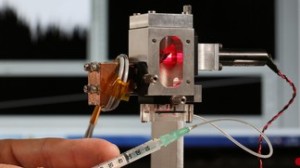Oct 3 2013
Nano and laser technology packed into small device tests antibiotic treatment in minutes
 The measuring device © EPFL / Alain Herzog
The measuring device © EPFL / Alain Herzog
Researchers at EPFL have built a matchbox-sized device that can test for the presence of bacteria in a couple of minutes, instead of up to several weeks. A nano-lever vibrates in the presence of bacterial activity, while a laser reads the vibration and translates it into an electrical signal that can be easily read—the absence of a signal signifies the absence of bacteria. Thanks to this method, it is quick and easy to determine if a bacteria has been effectively treated by an antibiotic, a crucial medical tool especially for resistant strains. Easily used in clinics, it could also prove useful for testing chemotherapy treatment. The research is published in the latest issue of Nature Nanotechnology.
“This method is fast and accurate. And it can be a precious tool for both doctors looking for the right dosage of antibiotics and for researchers to determine which treatments are the most effective,” explains Giovanni Dietler.
Laser and nanotechnology read the bacteria’s metabolic activity
It currently takes a long time to measure a bacterial infection’s response to antibiotic treatment. Clinicians must culture the bacteria and then observe its growth, sometimes for almost a month, as is the case with tuberculosis, in order to determine if the treatment has been effective.
Thanks to advances in laser and optical technology, the EPFL team of physicists has reduced this time to a couple of minutes. To do so, Giovanni Dietler, Sandor Kasas and Giovanni Longo have exploited the microscopic movements of a bacterium’s metabolism.
These vital signs are almost unperceivable. In order to test for them, the researchers place the bacteria on an extremely sensitive measuring device that vibrates a small lever—only slightly thicker than a strand of hair—in the presence of certain activity. The lever then vibrates under the metabolic activity of the germs. These infinitely small oscillations, on the order of one millionth of a millimeter, determine the presence or absence of the bacteria.
To measure these vibrations, the researchers project a laser onto the lever. The light is then reflected back and the signal is converted into an electrical current to be interpreted by the clinician or researcher. When the electrical current is a flat line, one knows that the bacteria are all dead; it is as easy to read as an electrocardiogram.
A promising method for cancer treatment
The researchers have miniaturized the tool—it is currently the size of a matchbox. “By joining our tool with a piezoelectric device instead of a laser, we could further reduce its size to the size of a microchip,” says Giovanni Dietler. They could then be combined together to test a series of antibiotics on one strain in only a couple of minutes.
The researchers are currently evaluating the tool’s potential in other fields, notably oncology. They are looking into measuring the metabolism of tumor cells that have been exposed to cancer treatment to evaluate the efficiency of the treatment. “If our method also works in this field, we really have a precious tool on our hands that can allow us to develop new treatments and also test both quickly and simply how the patient is reacting to the cancer treatment,” says Sandor Kasas.